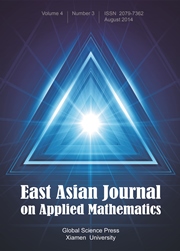Crossref Citations
This article has been cited by the following publications. This list is generated based on data provided by Crossref.
Feng, Xinlong
Song, Huailing
Tang, Tao
and
Yang, Jiang
2013.
Nonlinear stability of the implicit-explicit methods for the Allen-Cahn equation.
Inverse Problems & Imaging,
Vol. 7,
Issue. 3,
p.
679.
Chen, Lizhen
and
Xu, Chuanju
2013.
A Time Splitting Space Spectral Element Method for the Cahn-Hilliard Equation.
East Asian Journal on Applied Mathematics,
Vol. 3,
Issue. 4,
p.
333.
Zhai, Shuying
Feng, Xinlong
and
He, Yinnian
2014.
Numerical simulation of the three dimensional Allen–Cahn equation by the high-order compact ADI method.
Computer Physics Communications,
Vol. 185,
Issue. 10,
p.
2449.
Gu, Shuting
Zhang, Hui
and
Zhang, Zhengru
2014.
An energy-stable finite-difference scheme for the binary fluid-surfactant system.
Journal of Computational Physics,
Vol. 270,
Issue. ,
p.
416.
Feng, Xinlong
Tang, Tao
and
Yang, Jiang
2015.
Long Time Numerical Simulations for Phase-Field Problems Using $p$-Adaptive Spectral Deferred Correction Methods.
SIAM Journal on Scientific Computing,
Vol. 37,
Issue. 1,
p.
A271.
Li, Ning
Meng, Bo
Feng, Xinlong
and
Gui, Dongwei
2015.
The Spectral Collocation Method for the Stochastic Allen-Cahn Equation via Generalized Polynomial Chaos.
Numerical Heat Transfer, Part B: Fundamentals,
Vol. 68,
Issue. 1,
p.
11.
He, Yinnian
and
Feng, Xinlong
2016.
On uniform in time $H^2$-regularity of the solution for the 2D Cahn-Hilliard equation.
Discrete and Continuous Dynamical Systems,
Vol. 36,
Issue. 10,
p.
5387.
He, Yinnian
and
Feng, Xinlong
2016.
Uniform H2-regularity of solution for the 2D Navier–Stokes/Cahn–Hilliard phase field model.
Journal of Mathematical Analysis and Applications,
Vol. 441,
Issue. 2,
p.
815.
Li, Dong
Qiao, Zhonghua
and
Tang, Tao
2016.
Characterizing the Stabilization Size for Semi-Implicit Fourier-Spectral Method to Phase Field Equations.
SIAM Journal on Numerical Analysis,
Vol. 54,
Issue. 3,
p.
1653.
Song, Fangying
Xu, Chuanju
and
Karniadakis, George Em
2016.
A fractional phase-field model for two-phase flows with tunable sharpness: Algorithms and simulations.
Computer Methods in Applied Mechanics and Engineering,
Vol. 305,
Issue. ,
p.
376.
Uzunca, Murat
and
Karasözen, Bülent
2017.
Model Reduction of Parametrized Systems.
Vol. 17,
Issue. ,
p.
403.
Hou, Tianliang
Tang, Tao
and
Yang, Jiang
2017.
Numerical Analysis of Fully Discretized Crank–Nicolson Scheme for Fractional-in-Space Allen–Cahn Equations.
Journal of Scientific Computing,
Vol. 72,
Issue. 3,
p.
1214.
He, Ruijian
Chen, Zhangxin
and
Feng, Xinlong
2017.
Error estimates of fully discrete finite element solutions for the 2D Cahn–Hilliard equation with infinite time horizon.
Numerical Methods for Partial Differential Equations,
Vol. 33,
Issue. 3,
p.
742.
Song, Fangying
Xu, Chuanju
and
Karniadakis, George Em
2017.
Computing Fractional Laplacians on Complex-Geometry Domains: Algorithms and Simulations.
SIAM Journal on Scientific Computing,
Vol. 39,
Issue. 4,
p.
A1320.
Hou, T.
Wang, K.
Xiong, Y.
Xiao, X.
and
Zhang, Sh.
2017.
Discrete maximum-norm stability of a linearized second-order finite difference scheme for Allen–Cahn equation.
Numerical Analysis and Applications,
Vol. 10,
Issue. 2,
p.
177.
Li, Dong
and
Qiao, Zhonghua
2017.
On Second Order Semi-implicit Fourier Spectral Methods for 2D Cahn–Hilliard Equations.
Journal of Scientific Computing,
Vol. 70,
Issue. 1,
p.
301.
Xiao, Xufeng
Feng, Xinlong
and
Yuan, Jinyun
2017.
The stabilized semi-implicit finite element method for the surface Allen-Cahn equation.
Discrete & Continuous Dynamical Systems - B,
Vol. 22,
Issue. 7,
p.
2857.
Wang, Lin
and
Yu, Haijun
2018.
On Efficient Second Order Stabilized Semi-implicit Schemes for the Cahn–Hilliard Phase-Field Equation.
Journal of Scientific Computing,
Vol. 77,
Issue. 2,
p.
1185.
Xiao, Xufeng
Wang, Kun
and
Feng, Xinlong
2018.
A lifted local Galerkin method for solving the reaction–diffusion equations on implicit surfaces.
Computer Physics Communications,
Vol. 231,
Issue. ,
p.
107.
Karasözen, Bülent
Uzunca, Murat
Sariaydin-Fi̇li̇beli̇oğlu, Ayşe
and
Yücel, Hamdullah
2018.
Energy Stable Discontinuous Galerkin Finite Element Method for the Allen–Cahn Equation.
International Journal of Computational Methods,
Vol. 15,
Issue. 03,
p.
1850013.

